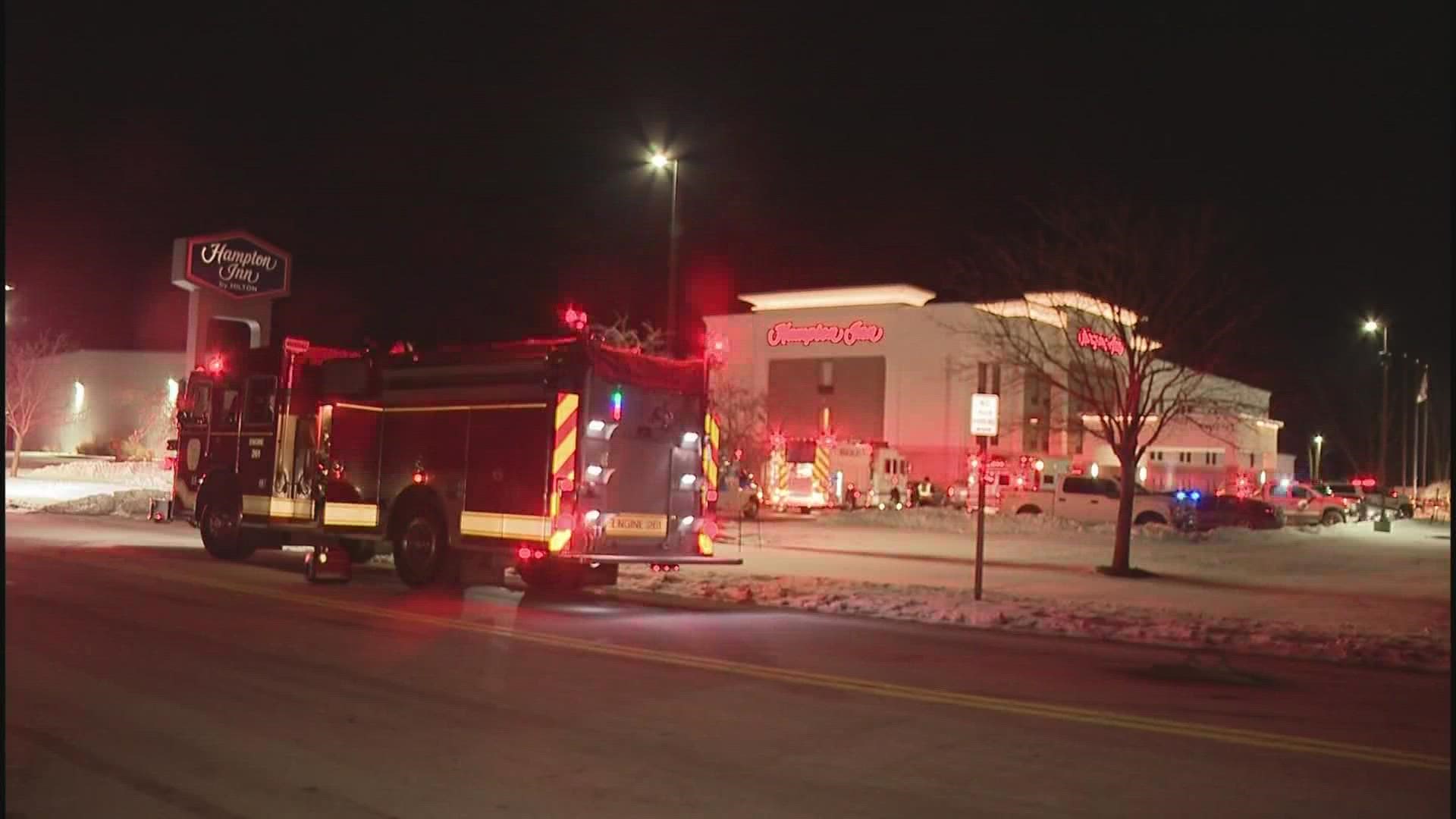COLUMBUS, Ohio — Marysville fire officials identified a pool heater as the suspected source of a carbon monoxide leak that sickened 14 people over the weekend at a Hampton Inn hotel.
Representatives from the Union County Health Department were on site Monday conducting additional inspections. Repair work on the pool heater had been done as recently as Thursday, according to Marysville Fire Chief Jay Riley.
A spokeswoman for the Union County health department said she had no knowledge of heater repair but was aware of repairs made to the flooring around the pool.
Riley says the hotel did have a carbon monoxide detector, but it didn’t activate.
10 Investigates reached out to the hotel operator with questions about the recent repair work and the carbon monoxide detector that failed to work. A spokesman for the Amerilodge Group, which operates this particular Hampton Inn, told us via email: “That matter is still being investigated. We will provide more information in the near future which we believe will answer your questions.”
All told, 14 people had to be treated at nearby hospitals following their exposure Saturday night to elevated levels of carbon monoxide. Riley told 10 Investigates his crews had never seen levels that high.
“Our gas meters were essentially kind of peaking out, which is unheard of. It’s the highest reading we have ever manually taken before,” Riley said in an interview Monday. “We didn’t even know that was possible to get that in a building because usually there is enough natural ventilation to have carbon monoxide escape. We were just taken aback by the levels we encountered on Saturday.”
A report by the Marysville Fire Department shows crews responding to an incident Saturday at the Hampton Inn found elevated levels of carbon monoxide throughout the hotel – including one reading in the pool area showing CO levels above 1.300 parts per million.
The dispatch fire report, obtained by 10 Investigates, revealed that crews “upon entering the pool area, the alarms on both (gas) meters immediately began sounding.” The report notes that fire crews’ equipment also noted crews were getting “readings as high as 1324 ppm” of carbon monoxide in the pool area.
Crews that arrived Saturday evening around 5:30 p.m. then began shutting off all mechanical systems in the pool room and opening doors to ventilate.
Hotel staff also notified guests to evacuate the hotel as fire crews discovered a range of carbon monoxide levels from as low as 7 to 50 parts per million in some rooms to as high as 600 parts per million on the third floor.
Upon being dispatched to the scene, fire crews were met with two to three children who had fallen ill – all had been in the pool area.
The incident sickened at least 14 people – which included both adults and children who had to be hospitalized following the exposure. A separate fire report from Sunday notes Columbia Gas had been on the scene. Crews were leaving the pool heater shut off.
We are really fortunate that this didn’t happen in the middle of the night. If this were to have happened in the middle of the night. We could’ve had tens of people that would’ve been fatalities. 13:09;02 Really fortunate that this was during waking hours,” Chief Riley said.
The Occupational Safety and Health Administration’s permissible exposure limit for carbon monoxide is 50 parts per million parts of air (55 milligrams per cubic meter) as an eight-hour time-weighted average.
The National Institute for Occupational Safety and Health (NIOSH) has a recommended exposure limit of 35 parts per million for eight hours.
The Consumer Product Safety Commission notes that “most people will not experience any symptoms from prolonged exposure to CO levels of approximately 1 to 70 ppm but some heart patients might experience an increase in chest pain. As CO levels increase and remain above 70 ppm, symptoms become more noticeable and can include headache, fatigue and nausea. At sustained CO concentrations above 150 to 200 ppm, disorientation, unconsciousness, and death are possible.”
Kris Hauschildt became an advocate for carbon monoxide awareness after her parents died in 2013 during a stay at North Carolina hotel. In that case, the source was a pool heater, she said.
Her organization, The Jenkins Foundation, now works to advocate for change and raise awareness about the dangerous of carbon monoxide exposure.
“My parents both died in the hotel overnight. They were found the next morning. And because there was no detection nobody knew why they were dead,” the Washington state woman told 10 Investigates during an interview Monday.
Because data is somewhat limited, Hauschildt says she had to cobbled together much of the research on her own by looking for published reports and news articles about carbon monoxide incidents at hotels across the country.
“I started a foundation to try to get this addressed. I have just become aware of how this is a larger issue. It’s not just hotels, it’s other commercial buildings. And is just a topic that suffers from getting the attention it needs.”
Her foundation has documented more than 300 carbon monoxide incidents at hotels dating back to the 1960s. Hauschildt told 10 Investigates that she believes that this is an underestimation of the true magnitude because fire service runs for carbon monoxide leaks often outpace published news articles about such incidents.
She encouraged those traveling to take precautions – including urging people to buy portable carbon monoxide monitors that they can take with them when they travel.
A spokeswoman for the Ohio State Fire Marshal told 10 Investigates that Ohio building codes do not require a carbon monoxide monitor specifically for pools, but that it is typical for the hotel buildings to have carbon monoxide detectors due to their heating and ventilation systems.

